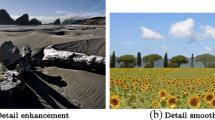Abstract
A method to improve the results of image enhancement is proposed. The idea of the method is to warp pixel grid by moving pixels towards the nearest image edges. It makes edges sharper while keeping textured areas almost intact. Experimental applications of the proposed method for image enhancement algorithms show the improvement of image quality.
Similar content being viewed by others
References
M. Almeida and M. Figueiredo, “Parameter estimation for blind and non-blind deblurring using residual whiteness measures,” IEEE Trans. Image Processing 22, 2751–2763 (2013).
J. Oliveira, J. M. Bioucas-Dia, and M. Figueiredo, “Adaptive total variation image deblurring: a majorization-minimization approach,” Signal Processing 89, 1683–1693 (2009).
S. D. Babacan, R. Molina, and A. K. Katsaggelos, “Variational bayesian blind deconvolution using a total variation prior,” IEEE Trans. Image Processing 18, 12–26 (2009).
N. Arad and C. Gotsman, “Enhancement by imagedependent warping,” IEEE Trans. Image Processing 8, 1063–1074 (1999).
J. Prades-Nebot et al., “Image enhancement using warping technique,” IEEE Electron. Lett. 39, 32–33 (2003).
A. Krylov, A. Nasonova, and A. Nasonov, “Grid warping for image sharpening using one-dimensional approach,” in Proc. Int. IEEE, Conf. on Signal Processing (ICSP2014) (Hangzhou, 2014), pp. 672–677.
J. Canny, “A computational approach to edge detection,” IEEE Trans. Pattern Anal. Mach. Intellig. 8, 679–698 (1986).
H. Sheikh, M. Sabir, and A. Bovik, “A statistical evaluation of recent full reference image quality assessment algorithms,” IEEE Trans. Image Processing 15 (11), 3440–3451 (2006).
A. A. Nasonova and A. S. Krylov, “Determination of image edge width by unsharp masking,” Comput. Math. Model. 25, 72–78 (2014).
J. G. Nagy, K. Palmer, and L. Perrone, “Iterative methods for image deblurring: A matlab object-oriented approach,” Num. Algorithms 36 (1), 73–93 (2004).
A. S. Krylov and A. V. Nasonov, “Adaptive image deblurring with ringing control,” in Proc. 5th Int. Conf. on Image and Graphics (ICIG’09) (Washington, 2009), pp. 72–75.
A. V. Nasonov and A. S. Krylov, “Grid warping in total variation image enhancement methods,” in Proc. Int. Conf. on Image Processing (ICIP2014) (Paris, 2014), pp. 4517–4521.
A. S. Krylov, A. A. Nasonova, and A. V. Nasonov, “Image warping as an image enhancement post-processing tool,” in Proc. 9th Open German-Russian Workshop on Pattern Recognition and Image Understanding (OGRW 2014) (Koblenz, 2015), pp. 132–135.
A. Nasonova and A. Krylov, “Deblurred images postprocessing by Poisson warping,” IEEE Signal Processing Lett. 22 (4), 417–420 (2015).
Author information
Authors and Affiliations
Corresponding author
Additional information
This paper uses the materials of the report submitted at the 9th Open German-Russian Workshop on Pattern Recognition and Image Understanding, held in Koblenz, December 1–5, 2014 (OGRW-9-2014).
The article is published in the original.
Andrei Serdzhevich Krylov (born 1956), graduated from the Faculty of Computational Mathematics and Cybernetics, Lomonosov Moscow State University (MSU) in 1978. Received the PhD degree in 1983, the Dr.Sc. degree in 2009. He is a professor and the head of the Laboratory of Mathematical Methods of Image Processing at the Faculty of Computational Mathematics and Cybernetics, MSU. His main research interests lie in mathematical methods of multimedia data processing and analysis.
Aleksandra Andreevna Nasonova (born 1989), graduated from the Faculty of Computational Mathematics and Cybernetics, Lomonosov Moscow State University (MSU) in 2011. Received the PhD degree in 2014. Currently a mathematician at the Department of Mathematical Physics of the Faculty of Computational Mathematics and Cybernetics, MSU. Her main research interests lie in mathematical methods of image processing.
Andrei Vladimirovich Nasonov (born 1985), graduated from the Faculty of Computational Mathematics and Cybernetics, Lomonosov Moscow State University (MSU) in 2007. Received PhD degree in 2011. Currently a senior researcher of the Laboratory of Mathematical Methods of Image Processing of the Faculty of Computational Mathematics and Cybernetics, MSU. His main research interests lie in variational methods of image processing, inverse and illposed problems.
Rights and permissions
About this article
Cite this article
Krylov, A.S., Nasonova, A.V. & Nasonov, A.A. Image enhancement by non-iterative grid warping. Pattern Recognit. Image Anal. 26, 161–164 (2016). https://doi.org/10.1134/S1054661816010132
Received:
Published:
Issue Date:
DOI: https://doi.org/10.1134/S1054661816010132




